Foundation Skills in Data Analysis: Employee Survey Report
VerifiedAdded on 2020/02/24
|7
|2207
|127
Report
AI Summary
This report presents an analysis of employee survey data collected from a sample of 400 employees at SuperPart. The analysis employs both descriptive and inferential statistical techniques to explore various aspects of the employee population. Key findings include a concentration of employees in the mid-age group (30-50 years), with limited representation from younger demographics. The study investigates the relationships between age, occupation, working hours, and income, revealing weak correlations in some areas. Employee satisfaction is found to be high, with a majority of employees expressing satisfaction. The analysis also examines the impact of union membership on job satisfaction and investigates the factors influencing attrition rates, suggesting the need for retention strategies. Additionally, the report addresses the average working hours, the proportion of non-unionized workers working overtime, and the level of unionization within the company. Finally, the report discusses the sufficiency of the sample size for future surveys.

Foundation Skills in Data Analysis
[Type the document subtitle]
STUDENT ID:
[Pick the date]
[Type the document subtitle]
STUDENT ID:
[Pick the date]
Paraphrase This Document
Need a fresh take? Get an instant paraphrase of this document with our AI Paraphraser
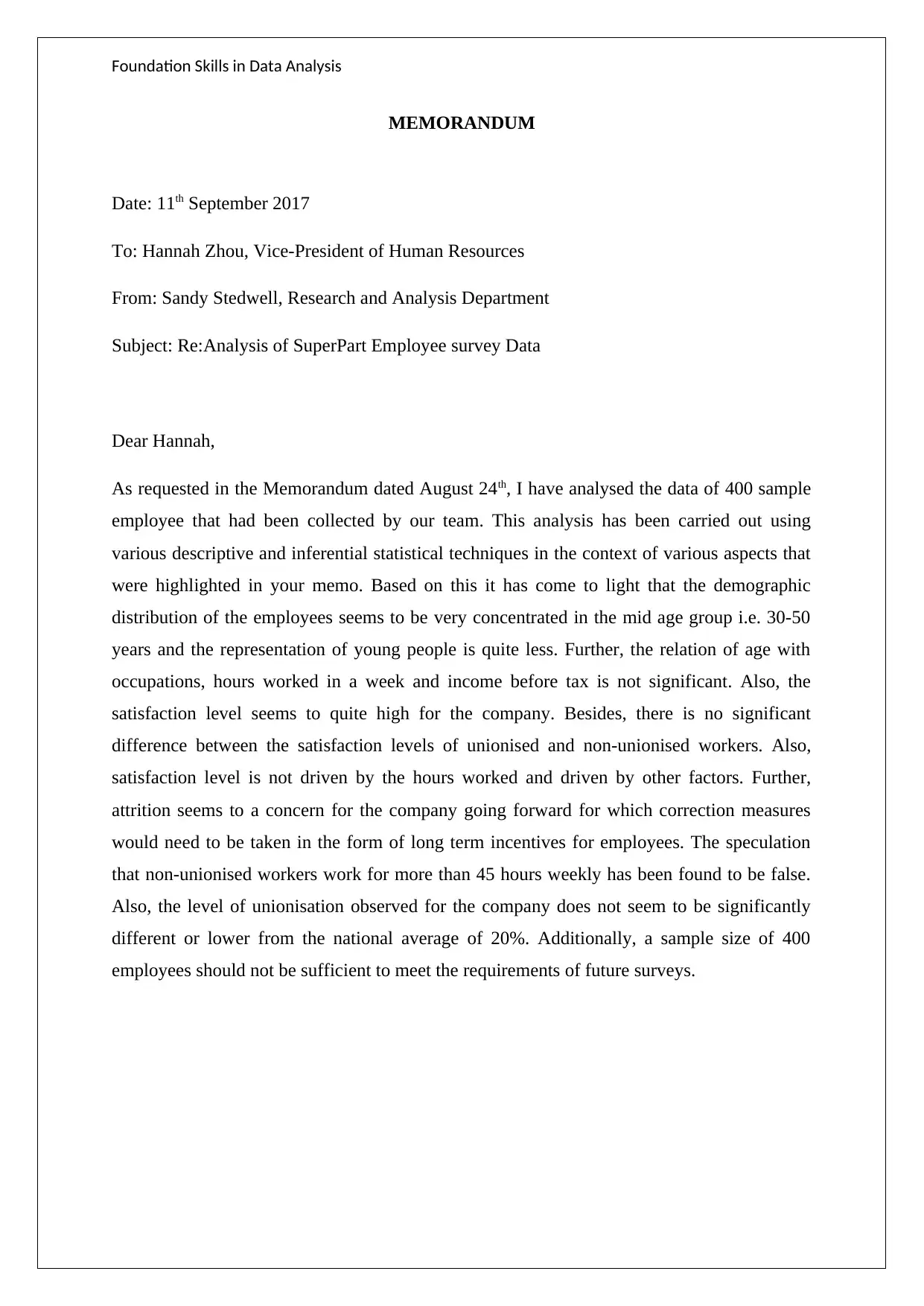
Foundation Skills in Data Analysis
MEMORANDUM
Date: 11th September 2017
To: Hannah Zhou, Vice-President of Human Resources
From: Sandy Stedwell, Research and Analysis Department
Subject: Re:Analysis of SuperPart Employee survey Data
Dear Hannah,
As requested in the Memorandum dated August 24th, I have analysed the data of 400 sample
employee that had been collected by our team. This analysis has been carried out using
various descriptive and inferential statistical techniques in the context of various aspects that
were highlighted in your memo. Based on this it has come to light that the demographic
distribution of the employees seems to be very concentrated in the mid age group i.e. 30-50
years and the representation of young people is quite less. Further, the relation of age with
occupations, hours worked in a week and income before tax is not significant. Also, the
satisfaction level seems to quite high for the company. Besides, there is no significant
difference between the satisfaction levels of unionised and non-unionised workers. Also,
satisfaction level is not driven by the hours worked and driven by other factors. Further,
attrition seems to a concern for the company going forward for which correction measures
would need to be taken in the form of long term incentives for employees. The speculation
that non-unionised workers work for more than 45 hours weekly has been found to be false.
Also, the level of unionisation observed for the company does not seem to be significantly
different or lower from the national average of 20%. Additionally, a sample size of 400
employees should not be sufficient to meet the requirements of future surveys.
MEMORANDUM
Date: 11th September 2017
To: Hannah Zhou, Vice-President of Human Resources
From: Sandy Stedwell, Research and Analysis Department
Subject: Re:Analysis of SuperPart Employee survey Data
Dear Hannah,
As requested in the Memorandum dated August 24th, I have analysed the data of 400 sample
employee that had been collected by our team. This analysis has been carried out using
various descriptive and inferential statistical techniques in the context of various aspects that
were highlighted in your memo. Based on this it has come to light that the demographic
distribution of the employees seems to be very concentrated in the mid age group i.e. 30-50
years and the representation of young people is quite less. Further, the relation of age with
occupations, hours worked in a week and income before tax is not significant. Also, the
satisfaction level seems to quite high for the company. Besides, there is no significant
difference between the satisfaction levels of unionised and non-unionised workers. Also,
satisfaction level is not driven by the hours worked and driven by other factors. Further,
attrition seems to a concern for the company going forward for which correction measures
would need to be taken in the form of long term incentives for employees. The speculation
that non-unionised workers work for more than 45 hours weekly has been found to be false.
Also, the level of unionisation observed for the company does not seem to be significantly
different or lower from the national average of 20%. Additionally, a sample size of 400
employees should not be sufficient to meet the requirements of future surveys.
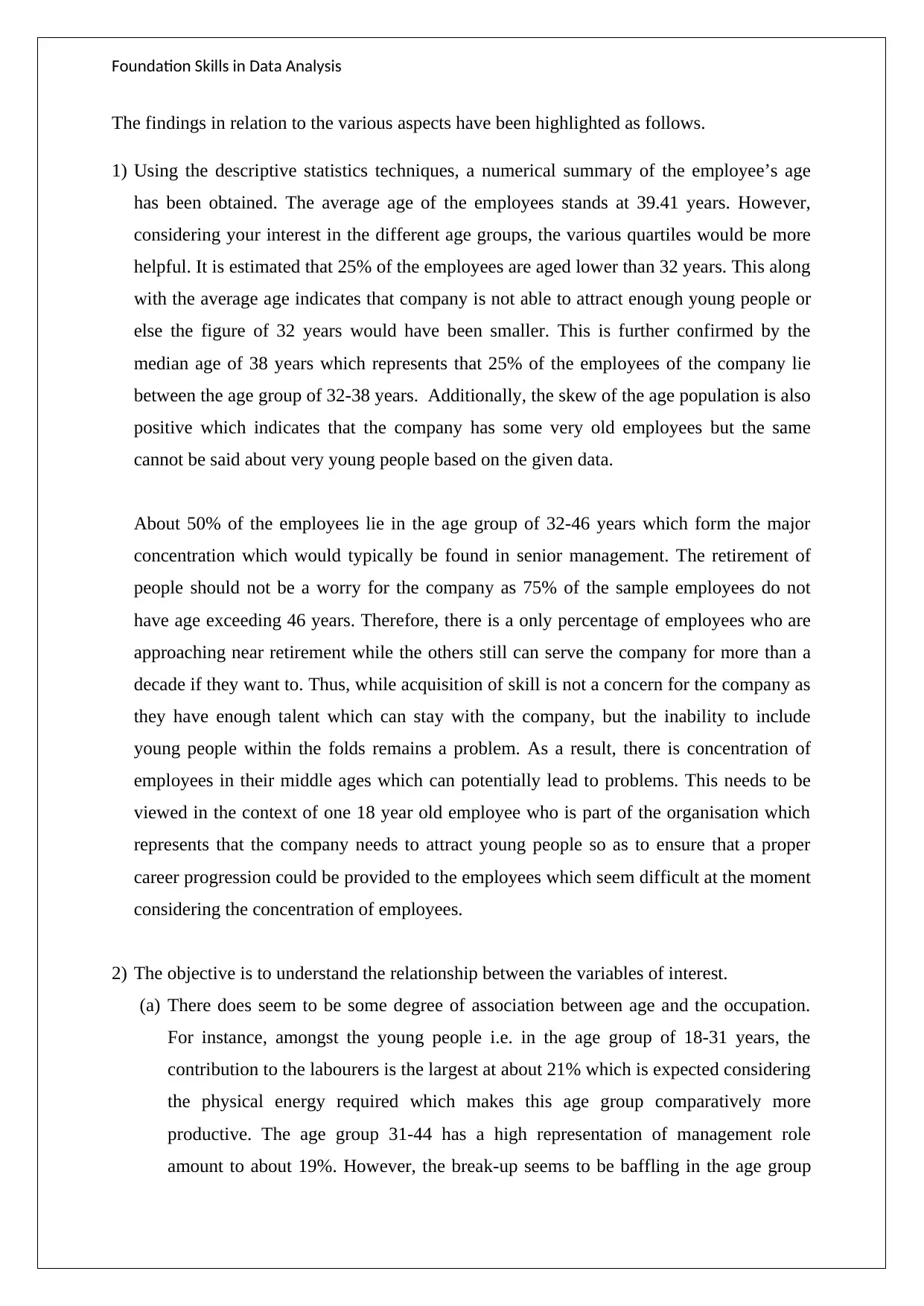
Foundation Skills in Data Analysis
The findings in relation to the various aspects have been highlighted as follows.
1) Using the descriptive statistics techniques, a numerical summary of the employee’s age
has been obtained. The average age of the employees stands at 39.41 years. However,
considering your interest in the different age groups, the various quartiles would be more
helpful. It is estimated that 25% of the employees are aged lower than 32 years. This along
with the average age indicates that company is not able to attract enough young people or
else the figure of 32 years would have been smaller. This is further confirmed by the
median age of 38 years which represents that 25% of the employees of the company lie
between the age group of 32-38 years. Additionally, the skew of the age population is also
positive which indicates that the company has some very old employees but the same
cannot be said about very young people based on the given data.
About 50% of the employees lie in the age group of 32-46 years which form the major
concentration which would typically be found in senior management. The retirement of
people should not be a worry for the company as 75% of the sample employees do not
have age exceeding 46 years. Therefore, there is a only percentage of employees who are
approaching near retirement while the others still can serve the company for more than a
decade if they want to. Thus, while acquisition of skill is not a concern for the company as
they have enough talent which can stay with the company, but the inability to include
young people within the folds remains a problem. As a result, there is concentration of
employees in their middle ages which can potentially lead to problems. This needs to be
viewed in the context of one 18 year old employee who is part of the organisation which
represents that the company needs to attract young people so as to ensure that a proper
career progression could be provided to the employees which seem difficult at the moment
considering the concentration of employees.
2) The objective is to understand the relationship between the variables of interest.
(a) There does seem to be some degree of association between age and the occupation.
For instance, amongst the young people i.e. in the age group of 18-31 years, the
contribution to the labourers is the largest at about 21% which is expected considering
the physical energy required which makes this age group comparatively more
productive. The age group 31-44 has a high representation of management role
amount to about 19%. However, the break-up seems to be baffling in the age group
The findings in relation to the various aspects have been highlighted as follows.
1) Using the descriptive statistics techniques, a numerical summary of the employee’s age
has been obtained. The average age of the employees stands at 39.41 years. However,
considering your interest in the different age groups, the various quartiles would be more
helpful. It is estimated that 25% of the employees are aged lower than 32 years. This along
with the average age indicates that company is not able to attract enough young people or
else the figure of 32 years would have been smaller. This is further confirmed by the
median age of 38 years which represents that 25% of the employees of the company lie
between the age group of 32-38 years. Additionally, the skew of the age population is also
positive which indicates that the company has some very old employees but the same
cannot be said about very young people based on the given data.
About 50% of the employees lie in the age group of 32-46 years which form the major
concentration which would typically be found in senior management. The retirement of
people should not be a worry for the company as 75% of the sample employees do not
have age exceeding 46 years. Therefore, there is a only percentage of employees who are
approaching near retirement while the others still can serve the company for more than a
decade if they want to. Thus, while acquisition of skill is not a concern for the company as
they have enough talent which can stay with the company, but the inability to include
young people within the folds remains a problem. As a result, there is concentration of
employees in their middle ages which can potentially lead to problems. This needs to be
viewed in the context of one 18 year old employee who is part of the organisation which
represents that the company needs to attract young people so as to ensure that a proper
career progression could be provided to the employees which seem difficult at the moment
considering the concentration of employees.
2) The objective is to understand the relationship between the variables of interest.
(a) There does seem to be some degree of association between age and the occupation.
For instance, amongst the young people i.e. in the age group of 18-31 years, the
contribution to the labourers is the largest at about 21% which is expected considering
the physical energy required which makes this age group comparatively more
productive. The age group 31-44 has a high representation of management role
amount to about 19%. However, the break-up seems to be baffling in the age group
⊘ This is a preview!⊘
Do you want full access?
Subscribe today to unlock all pages.

Trusted by 1+ million students worldwide
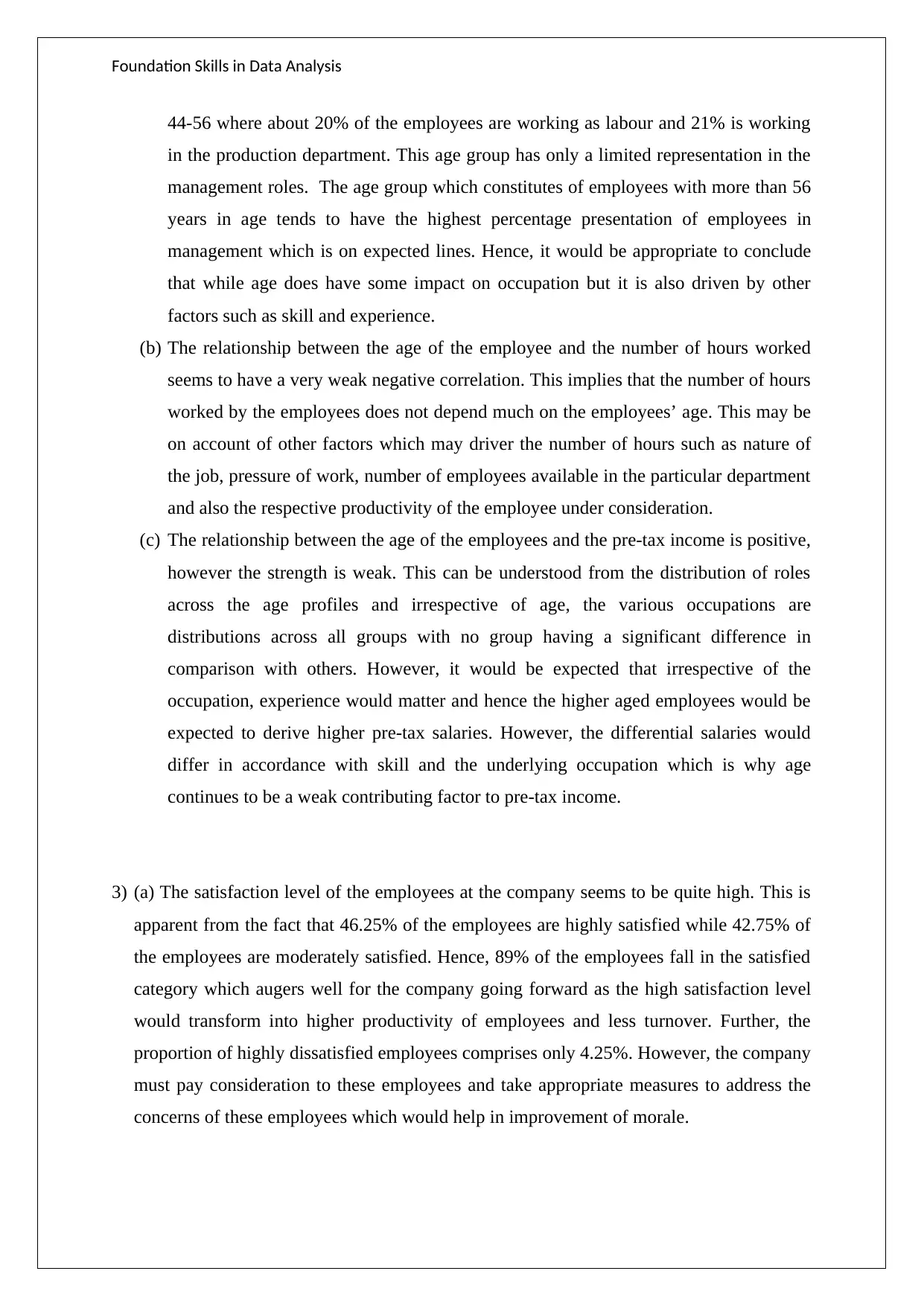
Foundation Skills in Data Analysis
44-56 where about 20% of the employees are working as labour and 21% is working
in the production department. This age group has only a limited representation in the
management roles. The age group which constitutes of employees with more than 56
years in age tends to have the highest percentage presentation of employees in
management which is on expected lines. Hence, it would be appropriate to conclude
that while age does have some impact on occupation but it is also driven by other
factors such as skill and experience.
(b) The relationship between the age of the employee and the number of hours worked
seems to have a very weak negative correlation. This implies that the number of hours
worked by the employees does not depend much on the employees’ age. This may be
on account of other factors which may driver the number of hours such as nature of
the job, pressure of work, number of employees available in the particular department
and also the respective productivity of the employee under consideration.
(c) The relationship between the age of the employees and the pre-tax income is positive,
however the strength is weak. This can be understood from the distribution of roles
across the age profiles and irrespective of age, the various occupations are
distributions across all groups with no group having a significant difference in
comparison with others. However, it would be expected that irrespective of the
occupation, experience would matter and hence the higher aged employees would be
expected to derive higher pre-tax salaries. However, the differential salaries would
differ in accordance with skill and the underlying occupation which is why age
continues to be a weak contributing factor to pre-tax income.
3) (a) The satisfaction level of the employees at the company seems to be quite high. This is
apparent from the fact that 46.25% of the employees are highly satisfied while 42.75% of
the employees are moderately satisfied. Hence, 89% of the employees fall in the satisfied
category which augers well for the company going forward as the high satisfaction level
would transform into higher productivity of employees and less turnover. Further, the
proportion of highly dissatisfied employees comprises only 4.25%. However, the company
must pay consideration to these employees and take appropriate measures to address the
concerns of these employees which would help in improvement of morale.
44-56 where about 20% of the employees are working as labour and 21% is working
in the production department. This age group has only a limited representation in the
management roles. The age group which constitutes of employees with more than 56
years in age tends to have the highest percentage presentation of employees in
management which is on expected lines. Hence, it would be appropriate to conclude
that while age does have some impact on occupation but it is also driven by other
factors such as skill and experience.
(b) The relationship between the age of the employee and the number of hours worked
seems to have a very weak negative correlation. This implies that the number of hours
worked by the employees does not depend much on the employees’ age. This may be
on account of other factors which may driver the number of hours such as nature of
the job, pressure of work, number of employees available in the particular department
and also the respective productivity of the employee under consideration.
(c) The relationship between the age of the employees and the pre-tax income is positive,
however the strength is weak. This can be understood from the distribution of roles
across the age profiles and irrespective of age, the various occupations are
distributions across all groups with no group having a significant difference in
comparison with others. However, it would be expected that irrespective of the
occupation, experience would matter and hence the higher aged employees would be
expected to derive higher pre-tax salaries. However, the differential salaries would
differ in accordance with skill and the underlying occupation which is why age
continues to be a weak contributing factor to pre-tax income.
3) (a) The satisfaction level of the employees at the company seems to be quite high. This is
apparent from the fact that 46.25% of the employees are highly satisfied while 42.75% of
the employees are moderately satisfied. Hence, 89% of the employees fall in the satisfied
category which augers well for the company going forward as the high satisfaction level
would transform into higher productivity of employees and less turnover. Further, the
proportion of highly dissatisfied employees comprises only 4.25%. However, the company
must pay consideration to these employees and take appropriate measures to address the
concerns of these employees which would help in improvement of morale.
Paraphrase This Document
Need a fresh take? Get an instant paraphrase of this document with our AI Paraphraser
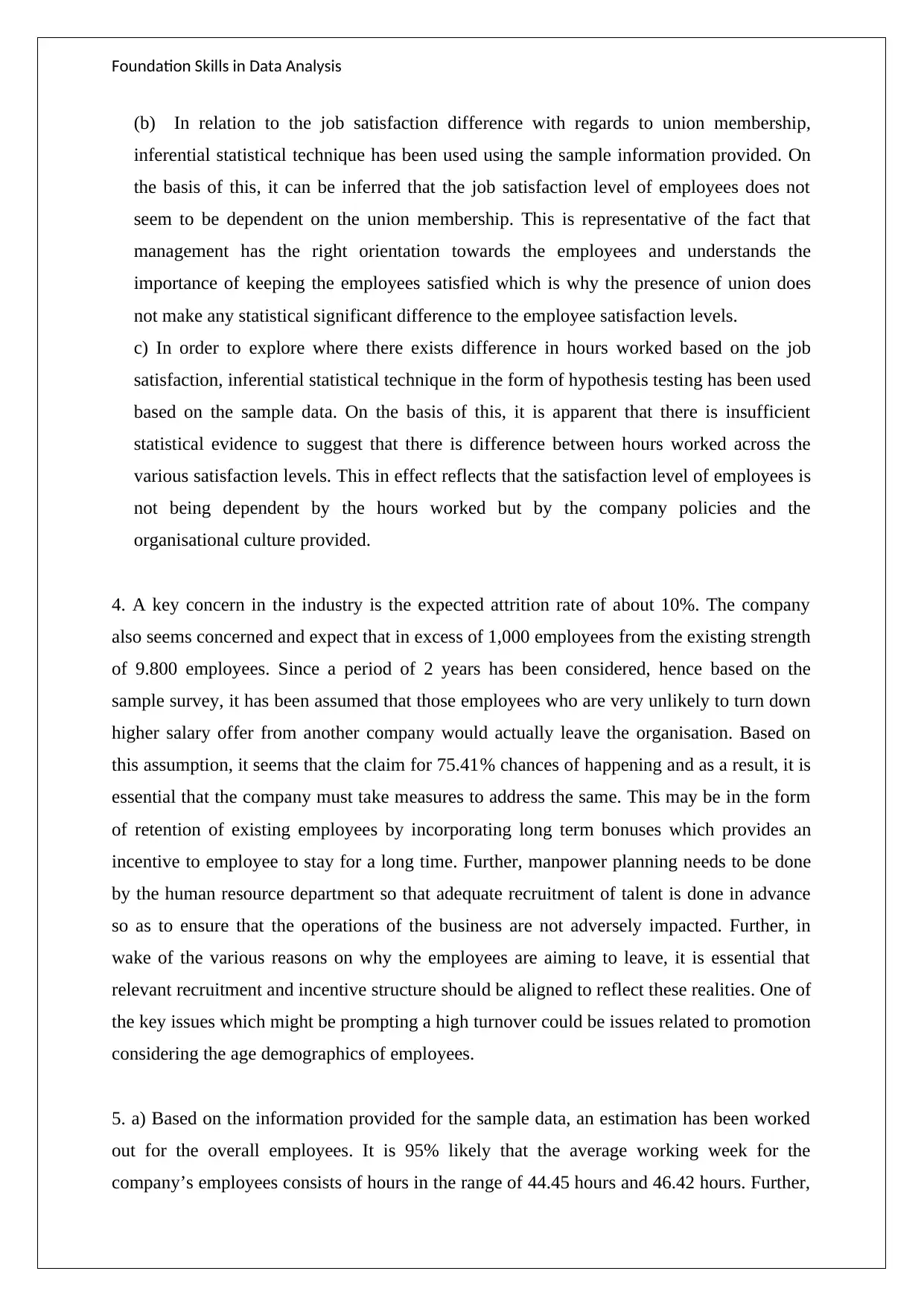
Foundation Skills in Data Analysis
(b) In relation to the job satisfaction difference with regards to union membership,
inferential statistical technique has been used using the sample information provided. On
the basis of this, it can be inferred that the job satisfaction level of employees does not
seem to be dependent on the union membership. This is representative of the fact that
management has the right orientation towards the employees and understands the
importance of keeping the employees satisfied which is why the presence of union does
not make any statistical significant difference to the employee satisfaction levels.
c) In order to explore where there exists difference in hours worked based on the job
satisfaction, inferential statistical technique in the form of hypothesis testing has been used
based on the sample data. On the basis of this, it is apparent that there is insufficient
statistical evidence to suggest that there is difference between hours worked across the
various satisfaction levels. This in effect reflects that the satisfaction level of employees is
not being dependent by the hours worked but by the company policies and the
organisational culture provided.
4. A key concern in the industry is the expected attrition rate of about 10%. The company
also seems concerned and expect that in excess of 1,000 employees from the existing strength
of 9.800 employees. Since a period of 2 years has been considered, hence based on the
sample survey, it has been assumed that those employees who are very unlikely to turn down
higher salary offer from another company would actually leave the organisation. Based on
this assumption, it seems that the claim for 75.41% chances of happening and as a result, it is
essential that the company must take measures to address the same. This may be in the form
of retention of existing employees by incorporating long term bonuses which provides an
incentive to employee to stay for a long time. Further, manpower planning needs to be done
by the human resource department so that adequate recruitment of talent is done in advance
so as to ensure that the operations of the business are not adversely impacted. Further, in
wake of the various reasons on why the employees are aiming to leave, it is essential that
relevant recruitment and incentive structure should be aligned to reflect these realities. One of
the key issues which might be prompting a high turnover could be issues related to promotion
considering the age demographics of employees.
5. a) Based on the information provided for the sample data, an estimation has been worked
out for the overall employees. It is 95% likely that the average working week for the
company’s employees consists of hours in the range of 44.45 hours and 46.42 hours. Further,
(b) In relation to the job satisfaction difference with regards to union membership,
inferential statistical technique has been used using the sample information provided. On
the basis of this, it can be inferred that the job satisfaction level of employees does not
seem to be dependent on the union membership. This is representative of the fact that
management has the right orientation towards the employees and understands the
importance of keeping the employees satisfied which is why the presence of union does
not make any statistical significant difference to the employee satisfaction levels.
c) In order to explore where there exists difference in hours worked based on the job
satisfaction, inferential statistical technique in the form of hypothesis testing has been used
based on the sample data. On the basis of this, it is apparent that there is insufficient
statistical evidence to suggest that there is difference between hours worked across the
various satisfaction levels. This in effect reflects that the satisfaction level of employees is
not being dependent by the hours worked but by the company policies and the
organisational culture provided.
4. A key concern in the industry is the expected attrition rate of about 10%. The company
also seems concerned and expect that in excess of 1,000 employees from the existing strength
of 9.800 employees. Since a period of 2 years has been considered, hence based on the
sample survey, it has been assumed that those employees who are very unlikely to turn down
higher salary offer from another company would actually leave the organisation. Based on
this assumption, it seems that the claim for 75.41% chances of happening and as a result, it is
essential that the company must take measures to address the same. This may be in the form
of retention of existing employees by incorporating long term bonuses which provides an
incentive to employee to stay for a long time. Further, manpower planning needs to be done
by the human resource department so that adequate recruitment of talent is done in advance
so as to ensure that the operations of the business are not adversely impacted. Further, in
wake of the various reasons on why the employees are aiming to leave, it is essential that
relevant recruitment and incentive structure should be aligned to reflect these realities. One of
the key issues which might be prompting a high turnover could be issues related to promotion
considering the age demographics of employees.
5. a) Based on the information provided for the sample data, an estimation has been worked
out for the overall employees. It is 95% likely that the average working week for the
company’s employees consists of hours in the range of 44.45 hours and 46.42 hours. Further,
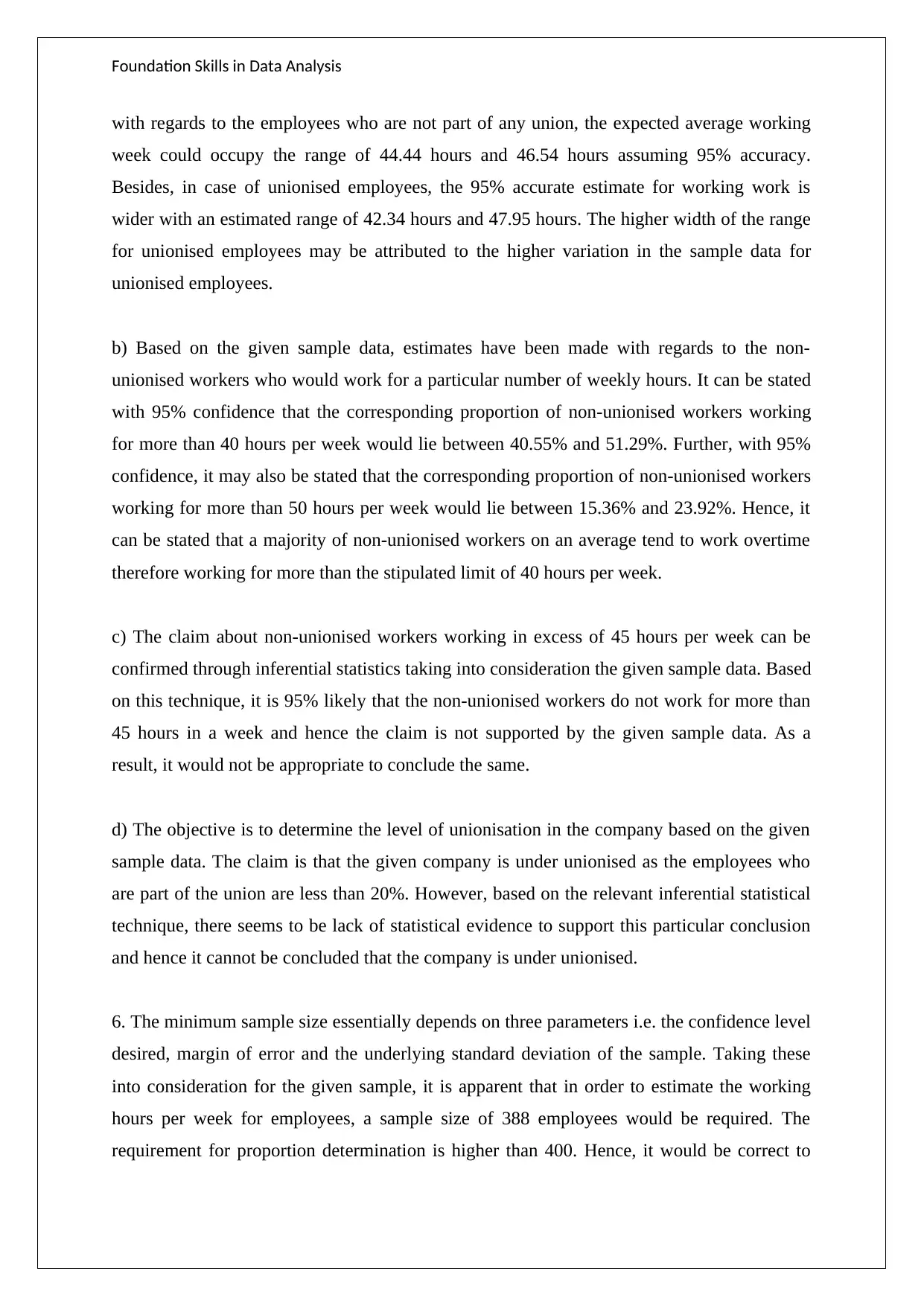
Foundation Skills in Data Analysis
with regards to the employees who are not part of any union, the expected average working
week could occupy the range of 44.44 hours and 46.54 hours assuming 95% accuracy.
Besides, in case of unionised employees, the 95% accurate estimate for working work is
wider with an estimated range of 42.34 hours and 47.95 hours. The higher width of the range
for unionised employees may be attributed to the higher variation in the sample data for
unionised employees.
b) Based on the given sample data, estimates have been made with regards to the non-
unionised workers who would work for a particular number of weekly hours. It can be stated
with 95% confidence that the corresponding proportion of non-unionised workers working
for more than 40 hours per week would lie between 40.55% and 51.29%. Further, with 95%
confidence, it may also be stated that the corresponding proportion of non-unionised workers
working for more than 50 hours per week would lie between 15.36% and 23.92%. Hence, it
can be stated that a majority of non-unionised workers on an average tend to work overtime
therefore working for more than the stipulated limit of 40 hours per week.
c) The claim about non-unionised workers working in excess of 45 hours per week can be
confirmed through inferential statistics taking into consideration the given sample data. Based
on this technique, it is 95% likely that the non-unionised workers do not work for more than
45 hours in a week and hence the claim is not supported by the given sample data. As a
result, it would not be appropriate to conclude the same.
d) The objective is to determine the level of unionisation in the company based on the given
sample data. The claim is that the given company is under unionised as the employees who
are part of the union are less than 20%. However, based on the relevant inferential statistical
technique, there seems to be lack of statistical evidence to support this particular conclusion
and hence it cannot be concluded that the company is under unionised.
6. The minimum sample size essentially depends on three parameters i.e. the confidence level
desired, margin of error and the underlying standard deviation of the sample. Taking these
into consideration for the given sample, it is apparent that in order to estimate the working
hours per week for employees, a sample size of 388 employees would be required. The
requirement for proportion determination is higher than 400. Hence, it would be correct to
with regards to the employees who are not part of any union, the expected average working
week could occupy the range of 44.44 hours and 46.54 hours assuming 95% accuracy.
Besides, in case of unionised employees, the 95% accurate estimate for working work is
wider with an estimated range of 42.34 hours and 47.95 hours. The higher width of the range
for unionised employees may be attributed to the higher variation in the sample data for
unionised employees.
b) Based on the given sample data, estimates have been made with regards to the non-
unionised workers who would work for a particular number of weekly hours. It can be stated
with 95% confidence that the corresponding proportion of non-unionised workers working
for more than 40 hours per week would lie between 40.55% and 51.29%. Further, with 95%
confidence, it may also be stated that the corresponding proportion of non-unionised workers
working for more than 50 hours per week would lie between 15.36% and 23.92%. Hence, it
can be stated that a majority of non-unionised workers on an average tend to work overtime
therefore working for more than the stipulated limit of 40 hours per week.
c) The claim about non-unionised workers working in excess of 45 hours per week can be
confirmed through inferential statistics taking into consideration the given sample data. Based
on this technique, it is 95% likely that the non-unionised workers do not work for more than
45 hours in a week and hence the claim is not supported by the given sample data. As a
result, it would not be appropriate to conclude the same.
d) The objective is to determine the level of unionisation in the company based on the given
sample data. The claim is that the given company is under unionised as the employees who
are part of the union are less than 20%. However, based on the relevant inferential statistical
technique, there seems to be lack of statistical evidence to support this particular conclusion
and hence it cannot be concluded that the company is under unionised.
6. The minimum sample size essentially depends on three parameters i.e. the confidence level
desired, margin of error and the underlying standard deviation of the sample. Taking these
into consideration for the given sample, it is apparent that in order to estimate the working
hours per week for employees, a sample size of 388 employees would be required. The
requirement for proportion determination is higher than 400. Hence, it would be correct to
⊘ This is a preview!⊘
Do you want full access?
Subscribe today to unlock all pages.

Trusted by 1+ million students worldwide

Foundation Skills in Data Analysis
conclude that a sample size of 400 employees would not be sufficient for the given
computations with the requisite margin of errors.
conclude that a sample size of 400 employees would not be sufficient for the given
computations with the requisite margin of errors.
1 out of 7
Related Documents
Your All-in-One AI-Powered Toolkit for Academic Success.
+13062052269
info@desklib.com
Available 24*7 on WhatsApp / Email
![[object Object]](/_next/static/media/star-bottom.7253800d.svg)
Unlock your academic potential
Copyright © 2020–2025 A2Z Services. All Rights Reserved. Developed and managed by ZUCOL.




